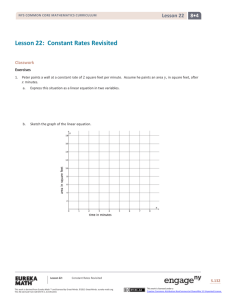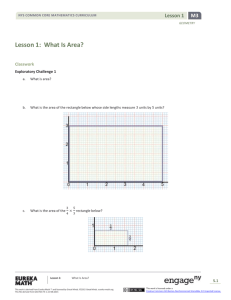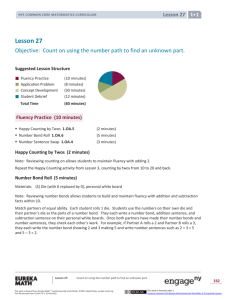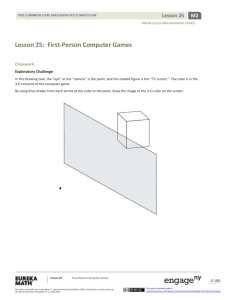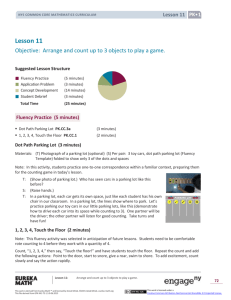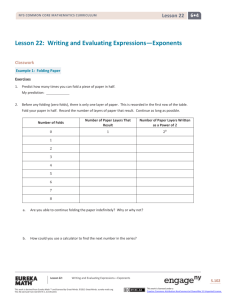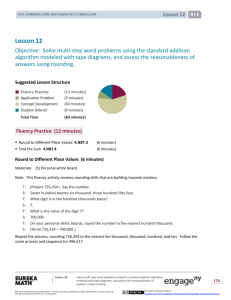Lesson 31 Sprint
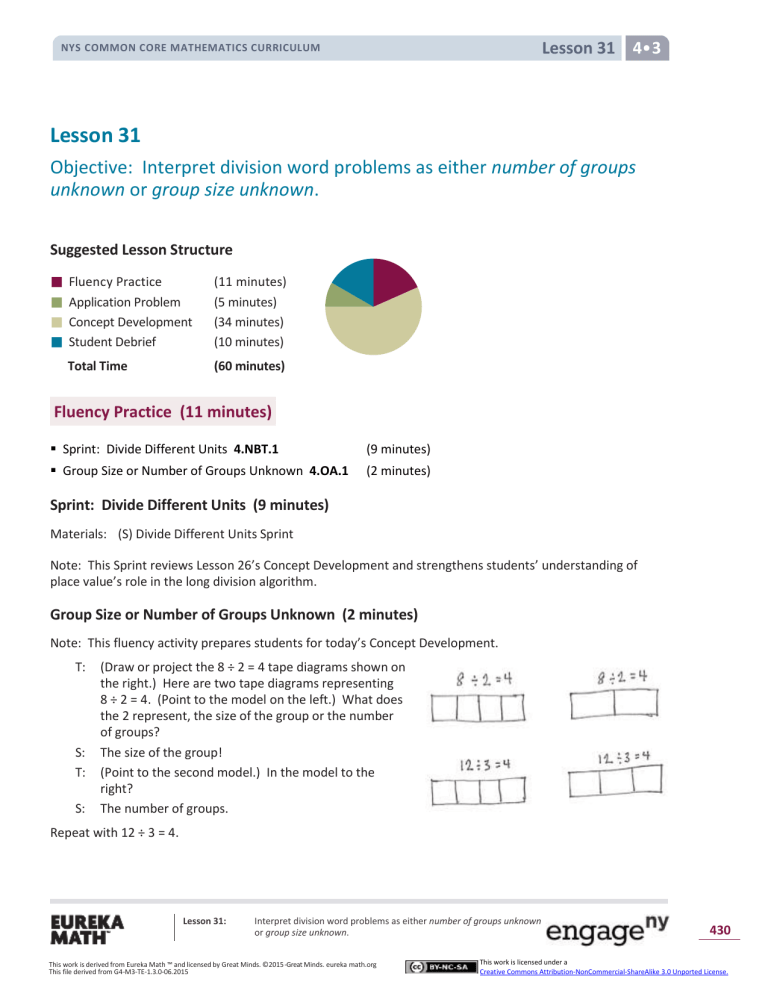
NYS COMMON CORE MATHEMATICS CURRICULUM
Lesson 31 4 3
Lesson 31
Objective: Interpret division word problems as either number of groups
unknown or group size unknown.
Suggested Lesson Structure
(11 minutes)
(5 minutes)
(34 minutes)
(10 minutes)
Total Time (60 minutes)
Fluency Practice (11 minutes)
Sprint: Divide Different Units 4.NBT.1 (9 minutes)
Group Size or Number of Groups Unknown 4.OA.1 (2 minutes)
Sprint: Divide Different Units (9 minutes)
Materials: (S) Divide Different Units Sprint
Note: This Sprint reviews Lesson 26’s Concept Development and strengthens students’ understanding of place value’s role in the long division algorithm.
Group Size or Number of Groups Unknown (2 minutes)
Note: This fluency activity prepares students for today’s Concept Development.
T: (Draw or project the 8 ÷ 2 = 4 tape diagrams shown on the right.) Here are two tape diagrams representing
8 ÷ 2 = 4. (Point to the model on the left.) What does the 2 represent, the size of the group or the number of groups?
S: The size of the group!
T: (Point to the second model.) In the model to the right?
S: The number of groups.
Repeat with 12 ÷ 3 = 4.
Lesson 31: Interpret division word problems as either number of groups unknown or group size unknown.
This work is derived from Eureka Math ™ and licensed by Great Minds. ©2015 -Great Minds. eureka math.org
This file derived from G4-M3-TE-1.3.0-06.2015
430
This work is licensed under a
Creative Commons Attribution-NonCommercial-ShareAlike 3.0 Unported License.
NYS COMMON CORE MATHEMATICS CURRICULUM
Lesson 31 4 3
Application Problem (5 minutes)
1,624 shirts need to be sorted into 4 equal groups. How many shirts will be in each group?
Note: This Application Problem is a review of Lesson 30, practicing with a zero in the quotient. In Problem 1 of the
Concept Development, students discuss whether the unknown in this problem is the group size or the number of groups.
Concept Development (34 minutes)
NOTES ON
MULTIPLE MEANS
OF ENGAGEMENT:
Differentiate the difficulty of the
Application Problem by adjusting the numbers.
Extend for students working above grade level with these questions:
How or why might the shirts be sorted?
Were you able to predict that a zero would be in the quotient? How?
Materials: (S) Personal white board
MP.5
Problem 1
Dr. Casey has 1,868 milliliters of Medicine T. She pours equal amounts of the medicine into 4 containers.
How many milliliters of medicine are in each container?
T: Can you draw something to help you solve this problem? What can you draw? Go ahead and do so.
S: (Draw.)
T: What did you draw?
S: I drew a tape diagram with the whole labeled as
1,868 milliliters. I made the whole into 4 equal parts because she poured the medicine into four containers.
T: What are we trying to find out?
S: We need to find out how many milliliters are in each container. We need to find the size of the group.
T: Right, we are finding the size of the group . We already know how many groups there are, four.
T: Let’s label the unknown with t for Medicine T.
T: Solve for how much medicine will be in each container. (Allow time for students to work.)
S: There will be 467 milliliters in each container.
Lesson 31: Interpret division word problems as either number of groups unknown or group size unknown.
This work is derived from Eureka Math ™ and licensed by Great Minds. ©2015 -Great Minds. eureka math.org
This file derived from G4-M3-TE-1.3.0-06.2015
431
This work is licensed under a
Creative Commons Attribution-NonCommercial-ShareAlike 3.0 Unported License.
NYS COMMON CORE MATHEMATICS CURRICULUM
Lesson 31 4 3
T: Compare this tape diagram to the one you drew in the Application Problem. Discuss the similarities.
Were you solving for the number of groups or the size of the group?
S: Both tape diagrams are broken into four groups. Both show we were solving for the size of each group.
Problem 2
T: (Draw or project the tape diagram shown below.) With your partner, discuss the tape diagram.
Then, create your own word problem to match. Remember to determine if you are finding the size of the group or the number of groups. (We might also express this choice as the number of measurements or the size of the measurements.)
Guide students to see that the equal partitioned parts of the tape diagram tell how many groups there are.
Students need to write a problem that asks for the number in each group or the size of the measurement.
Suggest the context of 168 liters of cleaning solution to be poured equally into 3 containers. Have a few sets of partners share their word problems to verify students are writing to solve for group size unknown.
Problem 3
Two hundred thirty-two people are driving to a conference. If each car holds 4 people, including the driver, how many cars will be needed?
T: Can you draw something to help you solve this problem? Go ahead. (Pause while students draw.)
What did you draw?
S: I drew a tape diagram with the whole labeled as 232 people.
T: Tell your partner how you partitioned the tape diagram. Are you finding the size of each group or the number of groups?
S: We made 4 equal parts because each car has
4 people in it. We know the size of the group. Each car has 4 people. We don’t know how many groups or how many cars.
We showed that 4 are in each car, but we don’t know the number of cars. Each unit of the tape diagram shows there are 4 people in each car, but we didn’t know how many cars to draw.
T: We labeled the tape diagram to show 4 people in each car and used a question mark to show we didn’t know how many cars were needed. Solve.
S: (Solve.)
Lesson 31: Interpret division word problems as either number of groups unknown or group size unknown.
This work is derived from Eureka Math ™ and licensed by Great Minds. ©2015 -Great Minds. eureka math.org
This file derived from G4-M3-TE-1.3.0-06.2015
432
This work is licensed under a
Creative Commons Attribution-NonCommercial-ShareAlike 3.0 Unported License.
NYS COMMON CORE MATHEMATICS CURRICULUM
Lesson 31 4 3
T: Tell your partner how you solved.
S: I divided 232 by 4. The quotient is 58.
Problem 4
T: (Draw or project the tape diagram shown below.)
With your partner, discuss the parts of the tape diagram. Then, write your own word problem to match. Remember to determine if you are solving for the size of the group or the number of groups.
(We might also express this choice as the number of measurements or the size of the measurements.)
NOTES ON
MULTIPLE MEANS
OF ACTION AND
EXPRESSION:
Give extra time and opportunities for discussion to English language learners and others as they write their own word problem. If time is an issue, use the suggestion mentioned or provide the following frame:
There are 138 _____.
If we put 3 ____ in each group, how many groups can be made?
Guide students to see the first partitioned part of the tape diagram tells how many are in each group.
Students need to write a problem that asks for the number of groups and account for a remainder.
Suggest the context of 138 feet of rope cut into 3-foot segments, solving for the number of ropes, or groups
(measurements). Have a few sets of partners share their word problems to verify students are writing to find the unknown number of groups. Have students compare and contrast the tape diagrams and word problems for this problem and Problem 2 of the Concept Development.
Problem Set (10 minutes)
Students should do their personal best to complete the
Problem Set within the allotted 10 minutes. For some classes, it may be appropriate to modify the assignment by specifying which problems they work on first.
Some problems do not specify a method for solving.
Students should solve these problems using the RDW approach used for Application Problems.
Student Debrief (10 minutes)
Lesson Objective: Interpret division word problems as either number of groups unknown or group size unknown.
The Student Debrief is intended to invite reflection and active processing of the total lesson experience.
Lesson 31: Interpret division word problems as either number of groups unknown or group size unknown.
This work is derived from Eureka Math ™ and licensed by Great Minds. ©2015 -Great Minds. eureka math.org
This file derived from G4-M3-TE-1.3.0-06.2015
433
This work is licensed under a
Creative Commons Attribution-NonCommercial-ShareAlike 3.0 Unported License.
NYS COMMON CORE MATHEMATICS CURRICULUM
Lesson 31 4 3
Invite students to review their solutions for the Problem Set. They should check work by comparing answers with a partner before going over answers as a class. Look for misconceptions or misunderstandings that can be addressed in the Debrief. Guide students in a conversation to debrief the Problem Set and process the lesson.
Any combination of the questions below may be used to lead the discussion .
How and why are the tape diagrams in Problems
1 and 2 different?
Share your tape diagram for Problem 3. What led you to draw a tape diagram to solve for the number of groups?
For Problem 3, if our tape diagram shows the whole divided into 3 equal groups instead, would we get the wrong quotient?
Compare your tape diagrams for Problem 2 and
Problem 4. Describe how your tape diagrams differ between one- and two-step problems.
If there are two unknowns, how do you determine which one to solve first?
If, for Problem 5, the tape diagram was drawn to show groups of 5, instead of 5 equal groups, how might that lead to challenges when solving the second part of the problem?
Exit Ticket (3 minutes)
After the Student Debrief, instruct students to complete the Exit Ticket. A review of their work will help with assessing students’ understanding of the concepts that were presented in today’s lesson and planning more effectively for future lessons. The questions may be read aloud to the students.
Lesson 31: Interpret division word problems as either number of groups unknown or group size unknown.
This work is derived from Eureka Math ™ and licensed by Great Minds. ©2015 -Great Minds. eureka math.org
This file derived from G4-M3-TE-1.3.0-06.2015
434
This work is licensed under a
Creative Commons Attribution-NonCommercial-ShareAlike 3.0 Unported License.
NYS COMMON CORE MATHEMATICS CURRICULUM
Lesson 31 Sprint 4 3
6 ÷ 2 =
60 ÷ 2 =
600 ÷ 2 =
6,000 ÷ 2 =
9 ÷ 3 =
90 ÷ 3 =
900 ÷ 3 =
9,000 ÷ 3 =
10 ÷ 5 =
15 ÷ 5 =
150 ÷ 5 =
1,500 ÷ 5 =
2,500 ÷ 5 =
3,500 ÷ 5 =
4,500 ÷ 5 =
450 ÷ 5 =
8 ÷ 4 =
12 ÷ 4 =
120 ÷ 4 =
1,200 ÷ 4 =
25 ÷ 5 =
30 ÷ 5 =
A
Divide.
13.
14.
15.
16.
9.
10.
11.
12.
5.
6.
7.
8.
1.
2.
3.
4.
17.
18.
19.
20.
21.
22.
30.
31.
32.
33.
34.
35.
36.
37.
23.
24.
25.
26.
27.
28.
29.
38.
39.
40.
41.
42.
43.
44.
Number Correct: _______
300 ÷ 5 =
3,000 ÷ 5 =
16 ÷ 4 =
160 ÷ 4 =
18 ÷ 6 =
1,800 ÷ 6 =
28 ÷ 7 =
280 ÷ 7 =
48 ÷ 8 =
4,800 ÷ 8 =
6,300 ÷ 9 =
200 ÷ 5 =
560 ÷ 7 =
7,200 ÷ 9 =
480 ÷ 6 =
5,600 ÷ 8 =
400 ÷ 5 =
6,300 ÷ 7 =
810 ÷ 9 =
640 ÷ 8 =
5,400 ÷ 6 =
4,000 ÷ 5 =
Lesson 31: Interpret division word problems as either number of groups unknown or group size unknown.
This work is derived from Eureka Math ™ and licensed by Great Minds. ©2015 -Great Minds. eureka math.org
This file derived from G4-M3-TE-1.3.0-06.2015
435
This work is licensed under a
Creative Commons Attribution-NonCommercial-ShareAlike 3.0 Unported License.
NYS COMMON CORE MATHEMATICS CURRICULUM
Lesson 31 Sprint 4 3
4 ÷ 2 =
40 ÷ 2 =
400 ÷ 2 =
4,000 ÷ 2 =
6 ÷ 3 =
60 ÷ 3 =
600 ÷ 3 =
6,000 ÷ 3 =
10 ÷ 5 =
15 ÷ 5 =
150 ÷ 5 =
250 ÷ 5 =
350 ÷ 5 =
3,500 ÷ 5 =
4,500 ÷ 5 =
450 ÷ 5 =
9 ÷ 3 =
12 ÷ 3 =
120 ÷ 3 =
1,200 ÷ 3 =
25 ÷ 5 =
20 ÷ 5 =
19.
20.
21.
22.
15.
16.
17.
18.
11.
12.
13.
14.
7.
8.
9.
10.
B
Divide.
1.
[KEY]
3.
4.
5.
6.
200 ÷ 5 =
2,000 ÷ 5 =
12 ÷ 4 =
120 ÷ 4 =
21 ÷ 7 =
2,100 ÷ 7 =
18 ÷ 6 =
180 ÷ 6 =
54 ÷ 9 =
5,400 ÷ 9 =
5,600 ÷ 8 =
300 ÷ 5 =
490 ÷ 7 =
6,300 ÷ 9 =
420 ÷ 6 =
4,800 ÷ 8 =
4,000 ÷ 5 =
560 ÷ 8 =
6,400 ÷ 8 =
720 ÷ 8 =
4,800 ÷ 6 =
400 ÷ 5 =
30.
31.
32.
33.
34.
35.
36.
37.
23.
24.
25.
26.
27.
28.
29.
38.
39.
40.
41.
42.
43.
44.
Number Correct: _______
Improvement: _______
Lesson 31: Interpret division word problems as either number of groups unknown or group size unknown.
This work is derived from Eureka Math ™ and licensed by Great Minds. ©2015 -Great Minds. eureka math.org
This file derived from G4-M3-TE-1.3.0-06.2015
436
This work is licensed under a
Creative Commons Attribution-NonCommercial-ShareAlike 3.0 Unported License.
NYS COMMON CORE MATHEMATICS CURRICULUM
Lesson 31 Problem Set 4 3
Name Date
Draw a tape diagram and solve. The first two tape diagrams have been drawn for you. Identify if the group size or the number of groups is unknown.
1.
Monique needs exactly 4 plates on each table for the banquet. If she has 312 plates, how many tables is she able to prepare?
312
4
…?...
2.
2,365 books were donated to an elementary school. If 5 classrooms shared the books equally, how many books did each class receive?
2,365
?
3.
If 1,503 kilograms of rice was packed in sacks weighing 3 kilograms each, how many sacks were packed?
Lesson 31: Interpret division word problems as either number of groups unknown or group size unknown.
This work is derived from Eureka Math ™ and licensed by Great Minds. ©2015 -Great Minds. eureka math.org
This file derived from G4-M3-TE-1.3.0-06.2015
437
This work is licensed under a
Creative Commons Attribution-NonCommercial-ShareAlike 3.0 Unported License.
NYS COMMON CORE MATHEMATICS CURRICULUM
Lesson 31 Problem Set 4 3
4.
Rita made 5 batches of cookies. There was a total of 2,400 cookies. If each batch contained the same number of cookies, how many cookies were in 4 batches?
5.
Every day, Sarah drives the same distance to work and back home. If Sarah drove 1,005 miles in 5 days, how far did Sarah drive in 3 days?
Lesson 31: Interpret division word problems as either number of groups unknown or group size unknown.
This work is derived from Eureka Math ™ and licensed by Great Minds. ©2015 -Great Minds. eureka math.org
This file derived from G4-M3-TE-1.3.0-06.2015
438
This work is licensed under a
Creative Commons Attribution-NonCommercial-ShareAlike 3.0 Unported License.
NYS COMMON CORE MATHEMATICS CURRICULUM
Lesson 31 Exit Ticket 4 3
Name Date
Solve the following problems. Draw tape diagrams to help you solve. Identify if the group size or the number of groups is unknown.
1.
572 cars were parked in a parking garage. The same number of cars was parked on each floor. If there were 4 floors, how many cars were parked on each floor?
2.
356 kilograms of flour were packed into sacks holding 2 kilograms each. How many sacks were packed?
Lesson 31: Interpret division word problems as either number of groups unknown or group size unknown.
This work is derived from Eureka Math ™ and licensed by Great Minds. ©2015 -Great Minds. eureka math.org
This file derived from G4-M3-TE-1.3.0-06.2015
439
This work is licensed under a
Creative Commons Attribution-NonCommercial-ShareAlike 3.0 Unported License.
NYS COMMON CORE MATHEMATICS CURRICULUM
Lesson 31 Homework 4 3
Name Date
Solve the following problems. Draw tape diagrams to help you solve. Identify if the group size or the number of groups is unknown.
1.
500 milliliters of juice was shared equally by 4 children. How many milliliters of juice did each child get?
2.
Kelly separated 618 cookies into baggies. Each baggie contained 3 cookies. How many baggies of cookies did Kelly make?
3.
Jeff biked the same distance each day for 5 days. If he traveled 350 miles altogether, how many miles did he travel each day?
Lesson 31: Interpret division word problems as either number of groups unknown or group size unknown.
This work is derived from Eureka Math ™ and licensed by Great Minds. ©2015 -Great Minds. eureka math.org
This file derived from G4-M3-TE-1.3.0-06.2015
440
This work is licensed under a
Creative Commons Attribution-NonCommercial-ShareAlike 3.0 Unported License.
NYS COMMON CORE MATHEMATICS CURRICULUM
Lesson 31 Homework 4 3
4.
A piece of ribbon 876 inches long was cut by a machine into 4-inch long strips to be made into bows.
How many strips were cut?
5.
Five Martians equally share 1,940 Groblarx fruits. How many Groblarx fruits will 3 of the Martians receive?
Lesson 31: Interpret division word problems as either number of groups unknown or group size unknown.
This work is derived from Eureka Math ™ and licensed by Great Minds. ©2015 -Great Minds. eureka math.org
This file derived from G4-M3-TE-1.3.0-06.2015
441
This work is licensed under a
Creative Commons Attribution-NonCommercial-ShareAlike 3.0 Unported License.



